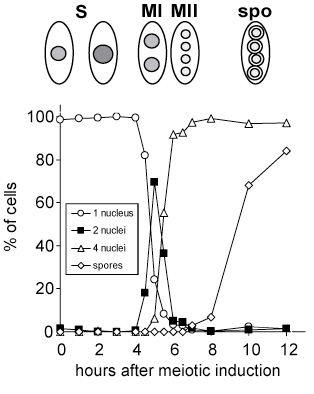Description of Experiments:
We have carried out different experiments to follow meiosis and sporulation in fission yeast diploid cells. To get good synchrony, we used thermosensitive mutants in the meiotic inhibitor pat1. As the pat1 experiment involves the use of mutant cells and a temperature-shift, we carried out controls in which non-sporulating cells were subject to the same treatment as pat1 cells. Finally, we used wild type diploid cells, which undergo meiosis and sporulation with lower synchrony. We also followed sexual differentiation in mutants of two transcription factors.
pat1 diploid meiosis:
To achieve the best possible synchrony we used thermosensitive mutants in
the meiotic inhibitor pat1. We first pre-synchronized vegetative diploid
cells in G1 by removal of nitrogen at the permissive temperature for pat1,
and then induced meiosis by inactivating pat1 with a temperature shift
(a small amount of nitrogen was added to the medium to improve synchrony).
The data are shown as ratios between the RNA level at each experimental
time point and the RNA level in vegetative cells. The temperature-shift
is done at time 0. Premeiotic S-phase takes place at ~2 h, and is accompanied
by chromosome pairing and recombination. The first meiotic division takes
place at 5 h and the second one at 5.5 h. The forespore membrane is formed
between 5.5 and 6.5 h, and mature spores appear at 10-12 h.

pat1+ diploid: non-sporulating control (no nitrogen added at temperature-shift):
Nitrogen starvation/temperature shifts controls (with no addition of nitrogen)
As a control for the pat1 experiment, non-sporulating pat1+ diploids were
treated as in the protocol for pat1 cells, except that no nitrogen was added
after the temperature shift. Under these conditions the cells remain blocked
in G1.
pat1+ diploid: non-sporulating control (nitrogen added at temperature-shift):
Nitrogen starvation/temperature shifts controls (with addition of nitrogen)
As a control for the pat1 experiment, non-sporulating pat1+ diploids were
treated exactly as in the protocol for pat1 cells. Note that under these
conditions the cells re-enter the mitotic cycle after the addition of nitrogen.
Wild type diploid meiosis:
To induce meiosis in wild type diploid cells, we removed nitrogen from
the medium. This type of meiosis is not very synchronous, but it mostly
confirms the data of the pat1 experiment.
Comparison of atf21 and atf31 mutants to wild type (h90 meiosis):
The transcription factors atf21 and atf31 are highly induced during the
meiotic divisions and required for proper spore formation. To identify
possible targets of these transcription factors we compared the
transcriptional profile of atf21 and atf31 mutants with that of wild type
cells undergoing meiosis. We used haploid h90 cells for this experiment.
Removal of nitrogen from the medium induces mating to form diploids, which
immediately undergo meiosis and sporulation. This type of meiosis is not
very synchronous.
